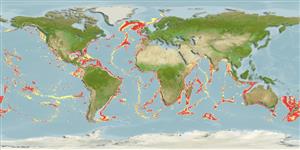>
Notacanthiformes (Halosaurs and deep-sea spiny eels) >
Halosauridae (Halosaurs)
Etymology: Aldrovandia: Taken from Ulisse Aldrovandi, (1522-1605), a Renaissance naturalist and physician noted by his systematic and accurate observations of plants and animals (Ref. 45335).
More on author: Vaillant.
Environment: milieu / climate zone / depth range / distribution range
Ecologia
marino benthopelagico; distribuzione batimetrica 500 - 2300 m (Ref. 4448). Deep-water
Probably circumglobal. Western Atlantic: New England, USA to Bahamas and off southern Brazil. Eastern Atlantic: northern Portugal to Guinea and off South Africa. Eastern Pacific: Hawaii and Chile (Ref. 9068). Western Indian Ocean: southern India. Eastern Indian Ocean: Western Australia (Ref. 49596).
Size / Peso / Age
Maturity: Lm ? range ? - ? cm
Max length : 50.0 cm TL maschio/sesso non determinato; (Ref. 27000)
Spine dorsali (totale) : 1; Raggi dorsali molli (totale) : 9 - 11. Body light grey in color; head silvery blue on top and sides, darker below and on gill covers (Ref. 3974). Lack of scales on the dorsal surface of the head and short maxillary spine (Ref. 37108).
Found between 530-2321 m, associated with islands and continental slopes (Ref. 58302). Found at bathyal to abyssal depths. Feeds on amphipods, mysids, copepods and polychaetes. Sexually dimorphic, maturing males have enlarged nostrils, anterior nostrils are black and tubular. Females outnumber males 4:1 in western North Atlantic.
Life cycle and mating behavior
Maturities | Riproduzione | Spawnings | Egg(s) | Fecundities | Larve
Sulak, K.J., 1990. Halosauridae. p. 126-132. In J.C. Quero, J.C. Hureau, C. Karrer, A. Post and L. Saldanha (eds.) Check-list of the fishes of the eastern tropical Atlantic (CLOFETA). JNICT, Lisbon; SEI, Paris; and UNESCO, Paris. Vol. 1. (Ref. 4448)
IUCN Red List Status (Ref. 130435)
Threat to humans
Harmless
Human uses
Strumenti
Special reports
Download XML
Fonti Internet
Estimates based on models
Preferred temperature (Ref.
123201): 2.5 - 8.8, mean 5.3 °C (based on 1006 cells).
Phylogenetic diversity index (Ref.
82804): PD
50 = 0.5156 [Uniqueness, from 0.5 = low to 2.0 = high].
Bayesian length-weight: a=0.00087 (0.00033 - 0.00229), b=3.07 (2.84 - 3.30), in cm total length, based on LWR estimates for this (Sub)family-body shape (Ref.
93245).
Trophic level (Ref.
69278): 3.2 ±0.34 se; based on food items.
Resilienza (Ref.
120179): Basso, tempo minimo di raddoppiamento della popolazione 4.5 - 14 anni (Assuming tmax>10).
Fishing Vulnerability (Ref.
59153): Moderate vulnerability (40 of 100).
Nutrients (Ref.
124155): Calcium = 11.6 [3.1, 41.9] mg/100g; Iron = 0.349 [0.115, 0.893] mg/100g; Protein = 1.57 [0.00, 5.42] %; Omega3 = 0.309 [0.115, 0.819] g/100g; Selenium = 19.8 [5.9, 73.7] μg/100g; VitaminA = 12.1 [2.3, 60.7] μg/100g; Zinc = 0.424 [0.219, 0.870] mg/100g (wet weight);
